This is an extended, and a little more personal, version of a post I wrote for our Liberal Arts and Natural Sciences blog (see here)
When I signed up to become Dean of Liberal Arts and Natural Sciences I was inspired by the interdisciplinary of the project. Thinking across boundaries has always been at the heart of my Classics. ‘How wonderful’, I thought, ‘to have the chance to design a whole new way of thinking about thinking, and to have a group of risk-taking, passionately adventurous students as my guinea-pigs first collaborators. Hurrah!’ If that seems a little flippant, it’s not for want of serious thought behind the project. I do genuinely believe that learning to learn in all kinds of unexpected environments, and from unfamiliar experiences, is crucial to becoming a creative, switched on individual; someone equipped to take advantage of every opportunity and make something of it to one’s advantage.
This tour represents one more element in our interest in putting students on the spot, outside the lecture theatre, and asking them to identify and evaluate complex challenges and ideas. It was also a personal challenge to me to step outside my comfort zone in leading a tour (already a complex enterprise!) which drew on my own discipline, but flowed well beyond its confines.
Planning started in Summer 2015. Our first two cohorts of students were in place, and each group had just completed one distinctive and extended extracurricular activity. Our first years were back from their leadership and team-building course at the Raymond Priestly Centre (the University’s base in the Lake District), and our second years had participated in our new capstone trip to Brussels, during which they considered European political processes and models, and gained perspective on the issues, provocations, and enterprising solutions tackled in their interdisciplinary breadth modules.
My research expertise as a Classicist has focused on questions of civic and personal identity in the late Roman Republic, but my teaching has encouraged students to explore the idea of the city, with particular focus on Rome as a way of interrogating the communities, languages, political transformations, rhetorics, ideologies, and historical sensitivities that cities manifest. The twentieth century is an obvious case-study, as Mussolini developed a new brand of national pride, one centred on the idea of permanence through continuity. His redesigned and rebranded Rome would be the third to rise as a global power in the footsteps of the ancient, thus first Rome, and the Rome of the Popes.
Urban studies, and the relationship of civic space to literary, historical, political, architectural, artistic, and religious trends, make for an invigorating interdisciplinary mix. The idea of taking a group of Liberal Arts and Natural Sciences students to Rome for a week, during which they would learn, and learn new kinds of questions to pose, was born.
The logistics were complex. To enable students to take the trip without impacting on their studies we needed to schedule the trip for June, and Rome in the heat of June needs careful thought. I was keen that students have the opportunity to receive some formal lectures as well as learn informally through walking the streets and visiting sites, so we partnered with the University of Arkansas Rome Center in order to benefit from their expertise in hosting international students, their ability to offer apartment-style accommodation, and (perhaps most of all) their glamorous base, located at the Palazzo Taverna (once home of the Orsini family, and more recently famous as a movie location, e.g. La Grande Bellezza) in the heart of the historic city. In addition, we worked with a professional tour guide, the amazing Agnes Crawford (of Understanding Rome).
Day 1
We were a group of twelve students, plus myself, Miriam Bay (a University of Birmingham doctoral researcher, and expert on the Villa d’Este, one of the sites we would visit), and Gideon Nisbet, one of the University of Birmingham’s Classicists. It was fascinating, over the course of day 1, to see the students arrive, mostly marvelling at the heat and the light and the ‘foreign’ quality to a city which so often seems central to the ‘family romance’ (as Leonard Barkan put it, writing in 1991) of Western civilisation.
Once the students had settled into their apartments, and done some independent exploring, we all reconvened at Palazzo Taverna in the grand Salon, jewelled with frescoes, for a welcome from Professor Davide Vitali (Director of the Rome Center, and Architect). This was followed by a 20-minute romp through Rome’s early and legendary foundation and republican history, touching on the political and ethical qualities (mos maiorum) that classical Romans believed to have been baked into citizen identity by the Founding Fathers (Patricians).
Next, we were treated to a whistle-stop lecture by University of Arkansas faculty-member Dr. Ryan Calabretta-Sajder tackling Rome’s identity as a cinematic city, starting with Roman Holiday (where else!) but ending up (via Fellini) with some interesting and provocative contemporary visions from Turkish-born director Ferzan Ozpetek. With that, we retired to a nearby restaurant for food, wine, and conversation.
Day 2
…started early — there had been some rumbling about our schedule of early meet-ups but once everyone realised the force of the sun (and the impossibility of meaningful site-visits during the full heat of the day) everyone agreed the necessity — at the Arch of Constantine.
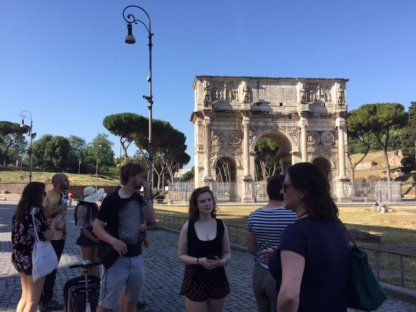
There, Agnes set in motion a series of iconographic and political themes that would become leitmotivs as the week progressed.
For a start, students were introduced to the powerful ideological and visual connotations of the arch form; also in the mix was the ‘spoliation’ which had led to this mishmash Arch making use of sculptural work and decorative elements repurposed from other, earlier monuments. The term spolia had powerful classical significance too, representing the military tokens won from a defeated enemy. The important interplay between monumental form, political ideology, and military might, took a different but complementary shape as we moved to the Flavian Amphitheatre, aka the Colosseum.
This site also helped students to get a sense of the hidden layers which urban markup conceals (and reveals) — the popular name ‘Colosseum’ was first associated with a gigantic statue of the last Julio-Claudian Emperor, Nero. The statue was part of a scheme for a massive palace connecting Rome’s Esquiline and Palatine Hills, and sprawling across the valley between. It was known as the Domus Aurea, or ‘Golden House’ on account of the richness and scale of its decor, but it became associated with what Nero’s enemies called his mad desire for (self-)aggrandisement.
Once the new Flavian emperor Vespasian solidified his control, the Domus Aurea was in part demolished and rezoned into a sequence of civic spaces (a public baths, an amphitheatre). The ‘colossal’ statue of Nero, rebranded as Sol (the sun), became part of the entertainment at the new amphitheatre, and lent its nickname to its new neighbour. We were certainly entertained!
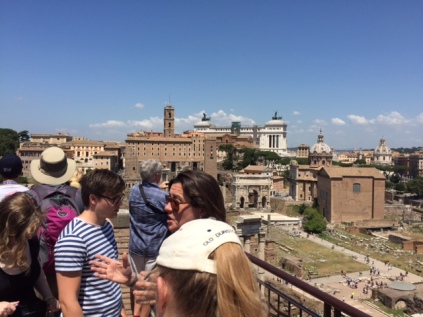
What remained of the morning was spent moving up and down the Palatine Hill, discussing how it transformed in the last years of the first century BCE from a pleasant residential zone (albeit one which also represented the site of Rome’s legendary foundation by Romulus!) to what would become the bureaucratic and autocratic heart of a transformed governmental system: in myth, Romulus founded the city and initiated a monarchy; legendarily, this monarchy was overthrown by a citizen body at odds with an increasingly ‘alien’ and tyrannical sequence of rulers, Etruscan by origin. In its place, res publica (public affairs, or commonwealth) because the model, and despite some hiccups, this model (led by two annually elected magistrates, the Consuls) survived intact until 27 BCE.
Multiculturalism and heterogeneity were part of Rome’s beginnings, but as an increasingly successful military superpower, Rome’s dominance first of the Italian peninsula and then (after defeating the other great power, Carthage) of the Mediterranean, meant that immigration, exposure to old and famous but now conquered civilisations (Greece, Egypt) and challenges to cultural norms by a cosmopolitan elite, were stretching old models of Roman identity. Breaking point came with the generalissimos of the first century BCE — Marius, Sulla, Pompey, Caesar, Antony.
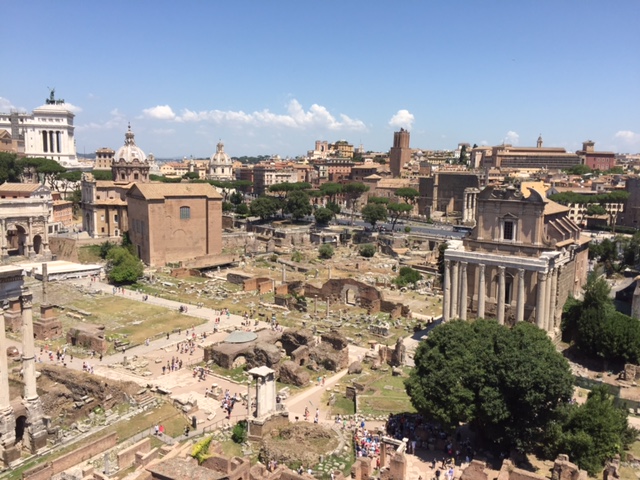
Students saw how one space, the traditional Forum Romanum, transformed from a focus for Rome’s civic self, increasingly became a venue for grandiose monuments and contestations of power which by the late Republic, often escalated into street violence and gang warfare, with electoral disruption happening year after year. The heat was becoming overpowering, and everyone was glad to follow Agnes across the Forum Romanum and out past the new imperial Fora, a sequence of building projects initiated by Augustus and continued by successive emperors to mark out their own particular brand of power and relationship to Rome’s corporate identity.
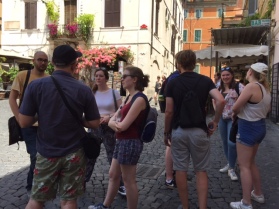
This was an area cleared by Mussolini of its medieval ‘clutter’ to expose and showcase (by driving a massive road, Via dell’Impero, now Via dei Fori Imperiali, through its heart) what could be found of the First Rome. Close to the Argiletum route into the Forum zone started the ancient road known as the Cliuus (or ‘Rise’) Suburanus.
Its route today can be traced in the medieval/Renaissance district of Monti, and in the charming Piazza della Madonna dei Monti we reconvened after lunch.

The morning focused on the classical cityscape. The afternoon saw Agnes take us through Rome’s medieval story, moving through the picturesque narrow streets that characterised the city as it re-found its power as a Christian capital and — with the Pilgrim trade developing — began to manifest new kinds of commercial and spiritual authority. Religious crises were a theme for the afternoon: we moved on through Rome’s Jewish Ghetto, exploring its history, the counter-reformation angle, and the complex urban texture linking this zone with striking manifestations of reuse of the classical past (the Theatre of Marcellus, become a palazzo; the Porticus of Octavia (named for Augustus’ sister), become a church).
Ship-shaped Tiber Island (some marble sculptural reliefs at the south, or ‘prow’ end, are all that remains of an ancient scheme to configure the island to represent a marbled boat) offered a welcome break for gelato, and some quick facts about the island’s history as a ‘hospital’ zone. This brought its ancient dedication to the imported Greek god Aesculapius (still in evidence on the sculpture emphasising the island’s ‘boat’ shape) into the mix. A temple to Aesculapius, a ‘healer’, existed from the early third century BCE in the aftermath of a serious plague; the structure was probably integrated into the church of San Bartolomeo, whose porch houses a plaque commemorating the last serious Tiber flood, in 1937.
Flooding was, of course, an integral part of Rome’s foundation legend (and a real spur to developing hydraulic expertise) — the story goes that it was flood water that swept the infant twins, Romulus and Remus, abandoned in a basket, from the main stream of the river, beaching them in the swampy valley that would become the Forum Romanum.
Trastevere (the place ‘across the Tiber’) was where our students’ apartments were located, close to the charming Piazza San Cosimato (with its amazing gelateria, Fatamorgana, and a characteristic produce market), so en route we took in two iconic churches linking the earliest post-classical Christian era with the developing power of the papacy: Santa Cecelia (unfortunately, closed, so we couldn’t see the famous Pietro Cavallini ‘Last Judgement’ frescoes, see here), and Santa Maria in Trastevere.

The latter bookended the day with some dramatic instances of spoliation (we challenged the students to spot the multiplicity of columns and capitals, not to mention bases, in evidence), and an outstanding example of what a dramatic and lavish decorative marble floor looks like (‘remember Domitian’s palace, on the Palatine?’ we asked them. This decor gave students a hint of what some of the floors might have been like…).
We all had some free time then, before reconvening back at Palazzo Taverna for a stand-out lecture by Professor Vitali explaining and exemplifying Rome as a ‘palimpsest’. The term was to become the watchword for the rest of the week, and I was tickled to see how the students responded to this scholarly but also lively and wide-ranging approach to what keeps Rome vital yet at the same time challenges its ability to re-make itself. I was also especially happy to hear Professor Vitali’s assessment of our students: one of the most inquiring, alert, and thoughtful groups he has worked with. In any mentoring relationship I find that I become very invested in the successes and achievements of those I’m working with; but the danger is that one becomes too invested in their progress to evaluate it with a cold eye…
Day 3
…began with another early start! We met at the caffe at the Porta San Paolo light rail station (some of us picked up an impromptu breakfast of cappuccini and cornetti as we waited) before boarding the train for Ostia Antica.
Once Rome’s port town, as the Tiber silted up (and eventually changed course, leaving Ostia Antica high and dry) the town was abandoned, and gradually fell into a mysterious quasi-burial. Not as dramatic a cessation of life as at Pompeii, but with surprisingly similar results in terms of excavated and visible ruins (and none of the crowds of Pompeii or Herculaneum).
Agnes gave two mini-lectures en route down the ancient Roman road into town, evocatively lined with extravagant tombs (like all significant roads in and out of Roman towns) forming a ‘city of the dead’ just beyond the walls of the living.
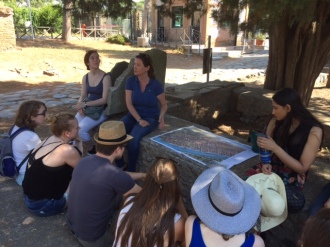
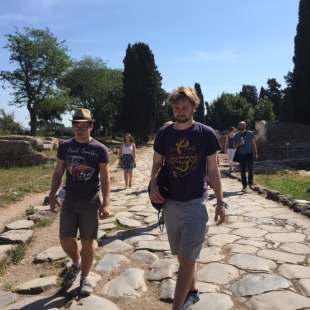
Ostia Antica is another site prioritised for excavation and display by Mussolini (complementing the Imperial Fora of Day 2), but also gives a vivid sense of the urban dynamics of walking down eerily quiet streets with multi-storey buildings still intact and available for entry.
Ostia also affords opportunities to see a version of Rome’s main civic religious structures (a temple to the Capitoline Triad), along with some of the more esoteric gods imported as Rome’s empire grew (Ostia boasts a number of Mithraea), and evidence of the new imperial cult which, after Augustus, saw emperors joining the divine pantheon and receiving temples and worship alongside traditional deities.
We saw dramatic mosaic pavements in some of the town’s public bath-houses and in the so-called Piazza of the Corporations (where trading companies had booths and offices decorated with mosaics representing their origins or business…), and we sat in the theatre, enjoying the views and contemplating the shift in scale from Rome’s Colosseum and Theatre of Marcellus.
The Theatre remains in use for an annual summer season (I saw a production of Plautus there a couple of summers ago — n.b., bring a cushion and deploy the anti-mozzie spray), but the hook from Ostia to EUR (our afternoon visit) was the ideological quality of the black and white mosaics, replicated at EUR (among other places, e.g. Foro Mussolini, and Stazione Ostiense; but we didn’t have time to bring the students everywhere!). In passing we managed to draw out another interesting connection: the mass-housing model from Ostia inspired scaled up versions in our neighbourhood, Testaccio, when affordable accommodation was needed for workers. Multi-storey structures afforded small but (for their time) airy and well-designed apartments arranged in rectangular blocks around communal central courtyards. Another repurposing of ancient Rome.
We strolled through some luxury townhouses (marvelling at one with its own private toilet!), and played at barmaid-and-customer in a remarkably intact bar (or perhaps ‘hot-food’ joint), before beginning to make our way back to the sleepy medieval town close to the site, and lunch at L’Alimentari (organised for us by Agnes).
Lunch was especially welcome after a morning tramping hard Roman roads in the sun, and we ate a lavish spread of antipasti, and then scoffed an imaginative pasta dish (a pesto sauce, given new interest with chopped pistachios), while sitting outdoors at long tables soaking up the shade and enjoying wide-ranging conversation. A particular delight for me, on this kind of trip, is the opportunity to get to know our students really well, and to have the kinds of debate that develop organically from interesting and unexpected situations and experience. This luncheon delivered such moments in spades!
Heading home, we got off the train at EUR (aka E42, Mussolini’s new-build site, designed for an Esposizione Universale di Roma in 1942) to take in some of the aftershocks of the recuperation of Ostia and to think further about what one does with ideologically compromised spaces and structures (interesting blog post here). And to eat more gelato.

EUR was framed as a way for the new regime to build the Rome of the future, free from the spatial and monumental constraints of the classical and papal city, and (as one of the monumental inscriptions puts it) to make this Third Rome ‘extend over other hills along the sacred river [Tiber] until it reaches the Tyrrhenian shore’. Slogans abound on the zone’s iconic buildings. The ‘Square Colosseum’ (formally, the Palazzo della Civiltà Italiana) characterises the Italians as ‘a people of poets, of artists, of heroes, of saints, of thinkers, of scientists, of navigators, of boundary-crossers’ (Mussolini, 1935) — rhetoric offering much food for thought.
Its arcades of arches ramp up the visuals of Rome’s Colosseum to the nth degree, while the square form nods (as we discussed on Days 4 and 5) to the square-plus-curve motif characteristic of the baroque mode. That the Square Colosseum is again gleaming in pristine splendour is thanks to the sponsorship of Fendi; so, like the Colosseum itself (beneficiary of Tod’s philanthropy underwriting its recent refurbishment), this also helped students to think through the problems associated with having too rich a patrimony. Italy as a whole both profits from, but perhaps even more so is in hock to, the wealth of sites to maintain, and but also to keep open.
Agnes prompted us to consider EUR as a surrealist project, recalling De Chirico and others in the van of twentieth-century intellectual experimentation. This vibe was particularly apt as we strolled to one of EUR’s other especially noteworthy buildings, the Palazzo degli Uffici dell’Ente Autonomo, we saw how the once-dramatic, visually (with spectacular black and white mosaics recalling some of the grandest at Ostia Antica) and aurally distinctive and refreshing water features become symptomatic of a wider lack of resource and denial of Rome’s watery life-blood to the site, when allowed to become derelict (like Ostia Antica, its watery purpose has changed course…). Now, the repurposing of a quote from Vergil’s epic poem, Aeneid (1.268-76) in which Jupiter (but ascribed to Romulus in the mosaic) promises Rome empire without end is next to invisible (we brought it out with some judiciously applied water).
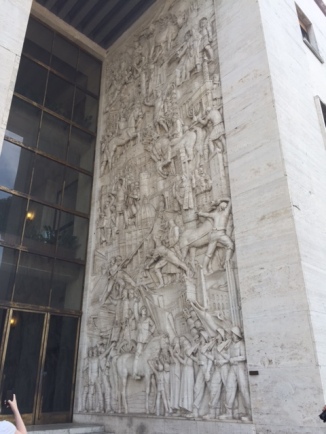
That Italian fascist vision of history as a triumphant advance from the foundation of Rome to the rule of Mussolini gains narrative expression in a massive sculptural relief (by Publio Morbiducci, which drew our brief visit to EUR to a close (we recommended that students come back another time, if interested, to see the great model of Rome housed in the Museo della Civilta Romana, another exercise in monumental architectural riffing on classical form for the dawn of a newly modern age).
We gave the students free time after EUR, and some went to see other sites in the city centre, some to have a snooze, and some to have a refreshment break.

We met up at Palazzo Taverna for our final evening lecture, this time by Miriam and introducing the gardens and water-features of the sixteenth-century theme park that is the Villa d’Este, a UNESCO World Heritage site about 45 minutes drive from Rome, in Tivoli — one of the fashionable mountain resort towns that surrounded ancient Rome, and continued in popularity as a summer retreat due to the freshness of the air. Before mosquitoes were identified as the main carriers, malaria was though to be product of the unhealthy summer miasmas (mal-aria) of swampy sites, such as Rome itself — after all, why else did the ancient Romans develop hydraulic expertise, and prioritise drain engineering?!
Day 4

We met at the Pantheon, a great spot to firm up the city’s palimpsestic quality — the inscription famously and boldly announces that Marcus Agrippa (A-d-C of Augustus) built it, but the structure that looms magnificently over the Renaissance Piazza della Rotonda was built more than a century later, was in fact a rebuild, by the emperor Hadrian (whose out-of-town villa, near Tivoli, we would be visiting on Day 5).
Like the Porticus of Octavia, the Pantheon (so called because it was a temple to ‘all’ the gods) survived (relatively) intact because it was reused as a church (Santa Maria dei Martiri); though the bronze roof ended up in Constantinople (thanks to Constans II), and the bronze portico ceiling went to make canon for Castel Sant’Angelo on the orders of Pope Urban VIII (and perhaps also contributed to Bernini’s baldachin in St. Peter’s).
Now, the Pantheon also houses tomb-monuments to unified Italy’s first rulers (Victor Emmanuel II; Umberto I), forming an interesting echo to one of the few ‘new’ builds in the historic centre of Rome after Italian unification and the instantiation of Roma Capitale (1870) – Il Vittoriano. We didn’t have time to fit that colossal white ‘typewriter’ (or ‘wedding cake’ as it is variously known) into the tour, but the monuments of the Pantheon offered a way into that part of the ‘capital’ side of Rome’s story (and some of the students made a trip to the Vittoriano during our long lunch-break).
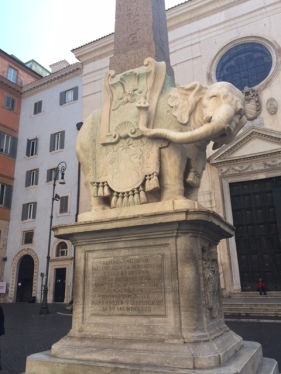
From the Pantheon we took a walking tour, stopping at Bernini’s elephant, and viewing the luminous Filippino Lippi frescoes in the Carafa Chapel of Santa Maria Sopra Minerva. Agnes emphasised to students how rich with layers this zone, once known as the Campus Martius (the classical city’s Field of Mars), is. The church has its name because of a long-gone shrine of ‘wise’ Minerva, by the Pantheon, that it evoked, while a temple of the Egyptian deity Isis was also once nearby (along with a swathe of entertainment and civic structures giving citizens an opportunity to do everything from vote, to see a show at the theatre, bathe, swim, exercise, or view works of art, many of which were booty displayed from Rome’s triumphant imperialism).
Bernini’s elephant neatly sums up the enduring power of empires to deform geographic norms by importing, terraforming, and translating entities between terrains and territories. But it also nods to the power of human curiosity, and evokes the darker side of that curiosity which slips often into exploitation and cruelty. Combined with the obelisk, other themes drift in. The obelisk likely belonged to the classical era Iseum (it was discovered in 1665 in the adjacent Dominican gardens), but combined with the elephant, it suggests a link with the Hypnerotomachia Poliphili, a mysterious work, full of arcana and allegory, and producing archetypes as waypoints along a route to wisdom. The work was possibly by the Dominican monk Francesco Colonna (and was published in 1499, by Aldo Manutius). A thorough article published in 2003 by Avigdor W. G. Posèq unpacks all this detail regarding the elephant’s genesis, and more (JStor subscription required); an older (1947) article by William S. Heckscher is open access, and just as useful for getting a flavour of the complexity.
We thought more about the papal city this morning, and used visits to (e.g.) Sant’Ignazio (with its trippy ‘fake’ dome) to discuss counter-reformation politics and the ways in which art and architecture were leveraged to create a sense of perfect union between man and god, and manifest some of the mysteries of christianity in experiential form. Moving on, we saw the Piazza di Pietra, in which a temple to the posthumously deified emperor Hadrian has been incorporated into what was once the Stock Exchange. We had a gelato stop next, before working our way through the narrow twisting streets that eventually give onto the spectacular Piazza Navona. Agnes used this opportunity to remind students about palimpsests: the piazza takes the form of a race track because it follows the lines of the Stadium of Domitian (of which now below-ground remnants are still accessible), that formed another part of the Flavian dynasty’s determination to entertain Rome.
The baroque splendours of Bernini’s Fountain of Four Rivers gave us a glimpse of the territorial ambitions of the post-Renaissance world, encompassing the greatest known rivers in a water-feature. Geopolitics writ in stone making the waters of the world flow symbolically for Rome, in Rome.
We moved back in time as we headed towards our lunch-break.

At Largo Argentina, a square within which the remains of Republican era temples are visible, but beneath one of whose sides sits the edge of Pompey’s theatre complex. There, in a meeting hall where Rome’s Senate was meeting on the Ideas of March 44 BCE, lies the site of Caesar’s assassination.
We set the students free to explore, with a longer break than usual to allow for the heat and airlessness of the city centre’s narrow streets. We would meet again at the Altar of Augustan Peace (the Ara Pacis), a monument excavated on Mussolini’s orders and relocated to a piazza created to contextualise the Mausoleum of Augustus within a carefully designed architectural setting foregrounding the achievements of fascism and its historical continuity with the power of ancient Rome.
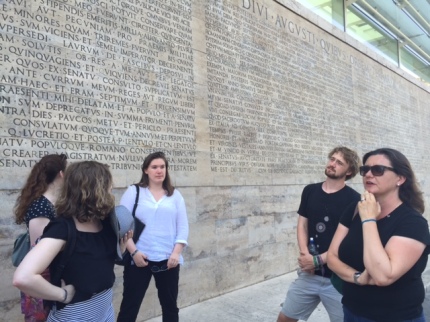
The Ara Pacis was dedicated by the Senate in 13 BCE, in honour of Augustus’ pacification of Spain and Gaul, and thus (for the most part) the Empire. Agnes helped students gain an understanding of the complex iconography. Outside, inscribed on the long wall facing the Mausoleum of Augustus, is the text of Augustus’ record of his achievements (Res Gestae), said to have been ‘published’ after his death on columns erected adjacent to the Mausoleum. The text only survives thanks to a version located in Ancyra, but its revival here speaks to the ongoing power of words as a form (or ‘sign’) as well as an articulation of authority. Turn one’s head in any direction around the piazza and see the 1930s assertions of intent and confidence enter the dialogue with the contemporary city’s rescripting of what it means to be heir to Augustus.
Inside, Agnes’ mission was to help students decode portrait representations of key figures, mythological images, and representations of flourishing nature supporting the new (Augustan) regime.

The museum, a (fairly) new building designed by starchitect Richard Meier (and the first new-build in the historic centre since the fascist era), offers an airy, cool space ideally suited to contemplating this masterpiece and also has helpful displays explaining the (not uncomplicated!) family tree of the Julio-Claudian imperial dynasty. Gideon set everyone looking for a mouse that he was sure he had seen among the whimsical fauna (including lizards, snails, baby birds being menaced by snakes…) but none of us could track it down. We declared it to be mythical!
Our original schedule had planned for St. Peter’s in the morning, followed by the Ara Pacis, with the Pantheon etc. after lunch. But this is Jubilee year in Rome, and luckily we had Agnes’ insider information that St. Peter’s was closed in the morning for a papal ceremony.
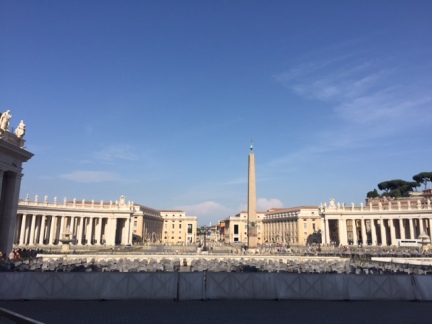
Hence, at the end of the day, we walked across the Tiber, past another classical mausoleum (of the emperor Hadrian) this time, repurposed as papal fortress, to the great street — Via della Concilazione — created by Mussolini to mark the new rapprochement between Vatican and secular authorities (a relationship made toxic by Italy’s ‘seizure’ of Rome as the new unified country’s capital in 1870), and creation of the Vatican State, through the Lateran Treaty.
Agnes’ canny timing of our visit meant that we faced no queues, and indeed had the privilege of entering St. Peter’s through the Holy Door (entrance is said, by the faithful, to grant remission of punishment for sins) — open for the 2016 Jubilee year.
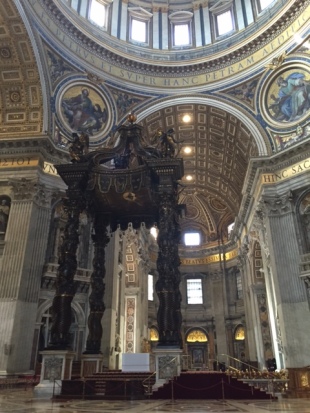
St. Peter’s remains a powerful space for Christianity, and as with each of the churches we visited, Agnes talked to us about what to look out for, and the history, before we went in. All the students agreed that it was an awe-inspiring experience, not just for its monumental scale, but in reflection of the powerful forces of belief that created and maintain it. I find myself newly moved by Michelangelo’s Pieta every time I visit, but seeing our students respond to art as a medium of faith and humanity, confronted by the sculpture, was hugely rewarding.
The students then had a free evening to reflect and refresh themselves. As did Miriam, Gideon, and myself.
Day 5
An easy meeting place for the students this morning: our guide, architectural historian and design specialist (and University of Arkansas Rome Center faculty member) Francesca Riccardo, and our minibus met us at the corner of Piazza San Cosimato. We were headed for the Villa Adriana (the Emperor Hadrian’s country estate) and Tivoli. Rome’s morning traffic is an eternal snarl-up, so our departure was a little later than planned. But once on the road and through the city limits the drive out to Villa Adriana through the lush countryside was a lovely respite from the marble and bustle of Rome.
Francesca’s architectural experience proved a revelation even for those of us who have visited the site in the past. Her insights (including anecdotes of Le Corbusier’s visit to the site) and her ability to tell a coherent narrative about monumental disposition, the rhythms of spaces and their dynamics, and the relationship between the architectural forms which broke or went far beyond ancient norms, offered a wholly novel way of thinking about the design concept.
The Villa is a hot, unshaded place on a late June day, and we ended up lingering at the iconic ‘Canopus’ pool, which gave me an opportunity to talk to students about the traditional ascription of names to parts of the estate. Politically characterised as ‘restless’, Hadrian was a controversial figure, not least for shifting the bureaucratic and governmental focus of Rome from the patriotic heart, the Forum zone, Capitoline, and Palatine to Tibur.
A late imperial biography of Hadrian suggested that he named parts of the villa for sites that particularly thrilled or pleased him, based on his travels around the empire. Canopus, in Egypt, might have recalled the tragic death of his lover Antinous, who drowned in the Nile; other sites were said to be named e.g. for Greece (‘Valley of Tempe’). It’s a great story, and historians and archaeologists have got great mileage, for centuries, in trying to puzzle out what each name tag might attach to.
The ‘Canopus’ pool (and attached dining-suite, complete with elaborate water-feature) plus the complex water features of the Piazza d’Oro and the (closed — but Francesca did a great job describing it) Teatro Marittimo structure proved a great way into thinking about how and why Cardinal Ippolito d’Este would, in the late sixteenth century, employ one of the men responsible for early archaeological work on the Villa Adriana (Pirro Ligorio) to design a spectacular water-garden. A landscape evoking classical myth and contemporary geo-politics, for his residence in Tivoli.
First, our minibus took us to Tivoli, where we had a brisk lunch break (including a mouth-watering and refreshing plate of pasta in a creamy — hence the ‘surprising’ aspect — lemon sauce), meeting up in an hour to start our tour of the Villa d’Este. We were exceptionally fortunate to have Miriam’s expertise joined to Francesca’s architectural knowledge for this part of the day-trip, and students were already well-primed thanks to Miriam’s evening lecture on day 3.
The Villa took shape in response to a failed political dream (Cardinal Ippolito d’Este’s unsuccessful attempt to become pope) and in its design he hoped to demonstrate — like Hadrian — that power could reside outside Rome. This site was connected not just to the Villa Adriana, but also to our Rome base at the Palazzo Taverna, where Ippolito lived for a time. Ippolito’s theme for the villa and its elaborately themed gardens was steeped in classical myth. It evoked Hercules’ legendary quest for the Golden Apples of the Hesperides, the dragon he fought to seize them, and the hero’s role as a powerful civiliser entwined (in Vergil’s Aeneid) with the site of what would one day become Rome.

Fountains send water trickling, babbling, pouring, gushing, and jetting up and down the hilly site, with automata, elaborate scenography, and hydraulic tricks combining to make this a magical kingdom, complete with (sadly now in serious disrepair) mini-Rome water-feature. This is the famous ‘Rometta’, once easily surpassing Rome, Vegas-style, when the real city is merely a dot on the horizon behind. The garden’s axis of water and iconography leads visitors on a stroll back-and-forth between Rome and Tivoli, reimagined for Ippolito’s schematisation of landscape as power. Visitors are challenged to see in Ippolito’s Tivoli a better-than-life vision of what power looks like, mediated through myth, geopolitics, cutting edge engineering, and the latest in archaeological discovery (drawing on Ligorio’s stop-press work at the Villa Adriana excavations).
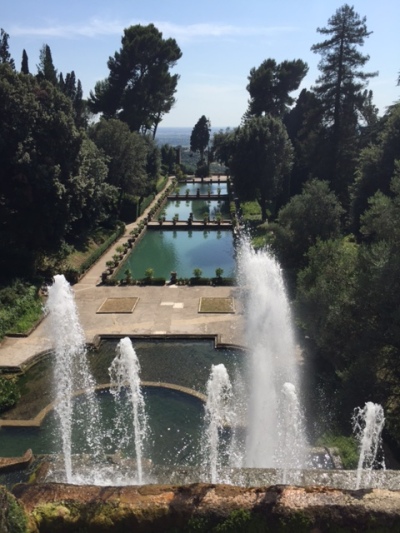
Originally, as Miriam reminded us, plantings used scent and sensory nudges to create and give atmosphere to particular routes through the gardens, while Ippolito’s villa, towering above, enjoyed a decorative scheme that recreated aspects of the garden experience indoors to satisfy any desire for summer shade (or mitigate against winter’s chill). We were lucky to be able to see and hear one of the surviving hydraulic features in action, the Fountain of the Organ played for us just before we left, adding melody to what had already been an extraordinary day.
Back in Rome we had a quick break, to allow students to return to their apartments and freshen up; then it was time for the farewell dinner at Ai Spaghettari, for which Agnes, and the Rome Center’s Viviana Sabbatini, rejoined us. What an opportunity to reflect on the week’s achievements, to soak up the convivial atmosphere, to discuss the new insights and approaches our visits had enabled, and — of course — to relax.
Day 6
Check-out day. Most of the students were leaving Rome, although some were staying on, or continuing their travels in Europe. For Miriam, Gideon, and myself it was a valuable day in which to think through what we ourselves had gained from the week. Not just refreshed perspectives on familiar (and some less familiar) sights, but also a vivid sense of our students’ thirst for enquiry, their willingness to think creatively even when extremely tired (and often very hot), their intellectual sparkiness, and their ability to notice and make something interesting from unexpected juxtapositions. Rome is a city of great dissonances as well as enormous beauty, and in these frictions, I think much of the most powerful learning resided. For our first years, fresh from their core interdisciplinary module on ‘modernity’, the lessons of history manifest in Rome were an excellent postscript to that semester 2 programme of study.
It was hard work, but in a good way. With the assistance of the Rome Center team, and with Agnes for three days, we think we developed a pretty strong narrative and a satisfyingly challenging week’s work. It gave me an opportunity to reimagine and review some of the things I tend to take as ‘given’ for sites that I know well — hearing interpretations and explanations from differently qualified experts was refreshing and thought-provoking, while answering questions from keen students with no prior knowledge helped me to see Rome afresh. One can’t ask for more than that.
{all photos © Diana Spencer, and taken 27 June-2 July 2016}


















Thoroughly enjoyed reading this and vicariously living the experience. Though nowhere near as knowledgeable as you on Roman history or classics (nowhere remotely near and I am not being Uriah Heep about this), I have now learned enough to be star-struck by what it has to offer us, still. (Pssst … ssshhh … can I tag along with you on another of these study tours?)
LikeLiked by 1 person
Definitely! Actually, I’m developing a ‘Varro’s Rome’ blogpost which would be a really good base for a few of us to do a ‘walk’ from — I’ll let you know 🙂
LikeLike
Great !
LikeLike